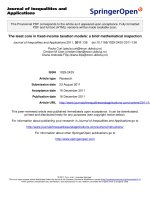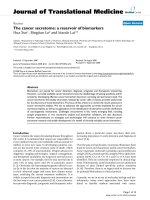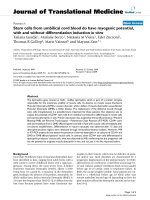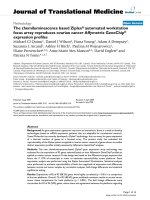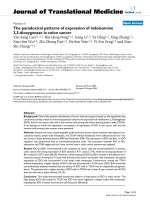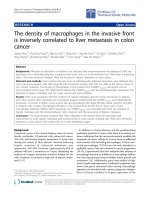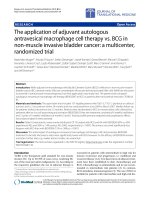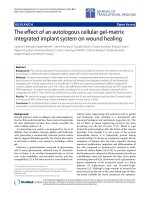Báo cáo hóa học: " The transfer from survey (map-like) to route representations into Virtual Reality Mazes: effect of age and cerebral lesion" doc
Bạn đang xem bản rút gọn của tài liệu. Xem và tải ngay bản đầy đủ của tài liệu tại đây (371.33 KB, 10 trang )
RESEARCH Open Access
The transfer from survey (map-like) to route
representations into Virtual Reality Mazes:
effect of age and cerebral lesion
Laura Carelli
1,2
, Maria Luisa Rusconi
1*
, Chiara Scarabelli
1
, Chiara Stampatori
3
, Flavia Mattioli
3
, Giuseppe Riva
2
Abstract
Background: To go from one place to another, we routinely generate internal representations of surrounding
spaces, which can include egocentric (body-centred) and allocentric (world-centred) coordinates, combined into
route and survey representations.
Recent studies have shown how both egocentric and allocentric representations exist in parallel and are joined to
support behaviour according to the task.
Our study investigated the transfer from survey (map-li ke) to route representations in healthy and brain-damaged
subjects. The aim was two-fold: first , to understand how this ability could change with age in a sample of healthy
participants, aged from 40 to 71 years old; second, to investigate how it is affected after a brain lesion in a 8
patients’ sample, with reference to specific neuropsychological frames.
Methods: Participants were first required to perform the paper and pencil version of eight mazes, then to translate
the map-like paths into egocentric route s, in order to find the right way into equivalent Virtual Reality (VR) mazes.
Patients also underwent a comprehensive neuropsychological evaluation, including a specific investigation of some
topographical orientation components.
Results: As regards the healthy sample, we found age-related deterioration in VR task performance. While
education level and gender were not found to be related to performance, global cognitive level (Mini Mental State
Examination), previous experience with computer and fluidity of navigation into the VR appeared to influence VR
task results.
Considering the clinical sample, there was a difficulty in performing the VR Maze task; executive functions and
visuo-spatial abilities deficits appeared to be more relevant for predicting patients ’ results.
Conclusions: Our study suggests the importance of developing tools aimed at investigating the survey to route
transfer ability in both healthy elderly and clinical samples, since this skill seems high cognitive demanding and
sensitive to cognitive decline.
Human-computer interaction issues should be considered in employing new technologies, such as VR
environments, with elderly subjects and neurological patients.
Background
The ability to find the right way into a novel or familiar
environment is a complex and multi-componential func-
tion [1,2].
To go from one place to another, we routinely gener-
ate internal representations of surrounding spaces,
which can include egocentric (body-centred) and allo-
centric (world-centred) coordinates [3,4]
Allocentric (world-centred) coordinates refer to salient
landmarks and their relative positions, whereas egocentric
(body-centred) coordinates rely on sensorimotor indexes
of head, trunk and body motion, updating the oncoming
information according to subjects’ movements into the
environment. Cognitive maps resulting from these two dif-
ferent ways of selecting and combining spatial topographi-
cal information are, respectively, named “survey” and
* Correspondence:
1
Department of Human Science, University of Bergamo, Bergamo, Italy
Full list of author information is available at the end of the article
Carelli et al. Journal of NeuroEngineering and Rehabilitation 2011, 8:6
/>JNER
JOURNAL OF NEUROENGINEERING
AND REHABILITATION
© 2011 Carelli et al; licensee BioMed Central Ltd. This is an Open Access article distributed under the terms of the Creative Commons
Attribution License ( es/b y/2.0), which permits unrestricted use, distribution, and reproduction in
any medium, provided the original work is properly cited.
“route” representations. Whereas survey representation
allows preserving Euclidean relationship between places in
the environment, route representations specify fixed
sequences of salient landmarks, describing a starting point,
a goal and a direction of movement [5].
In clinical conditions, several topographical impair-
ments, involving, for example, a loss of sense of familiar-
ity for known environments, landmark recognition
deficits or problems in memory for complex scenes, can
be observed.
There is a great amount of literature describing topogra-
phical disorientation after cerebral lesions [6-8]. A loss of
ability in wayfinding and place learning has been observed
after d iffuse impairment of the cerebral cortex (as in neuro-
degenerative disorders), or after focal lesions, in particular
affecting the right cerebral cortex. In the first case, general
impairments in attention, memory and perceptual abilities
lead to the inability to find the right way into known and
unknown places. Specific circuits and structures play an
important role in topographical orientation, in particular
medial temporal lobe regions, including hippocampus, para-
hippocampus, l ingual gyrus and retro-splenial cort ex [9-15].
Several studies have reported that also not pathologi-
cal aging can impair topographical abilities [16-20].
Age-related differences in cognitive functioning refer
to the ability to pay attention and infer information
from the world, learn and memorize, solve problems
and make decisions. Although the various components
of memory do not suffer a homogeneous decline, nor-
mal age-related cognitive decline mainly affects informa-
tion processing speed, attention, ability to inhibit
irrelevant or distracting information and working mem-
ory capacity. As a consequence, age differences emerge
when demanding storage and processing of informatio n
are simultaneously required [21].
Paper and pencil tests and ecological ad hoc experi-
mental situations are commonly used in order to evaluate
topographical orientation abilities. In particular, ecologi-
cal methods provide interesting information about strate-
gies used by patients to explore a natural environment.
On the other hand, the observation of a patient in daily
contexts generates many issues about the reliability and
interpretation of collected data. I n order to avoid biases,
the design of an effective assessment tool, that links a
reliable evaluation methodologywithamoresituated
observation of spatial behaviours, is needed.
An interesting tool to investigate topographical diffi-
culties, by integrating both reliability and ecological
validity requirements, is represented b y Virtual Reality
(VR) technology. VR offers both realness and experi-
mental control, providing a high dynami c and in terac-
tive representation of a complex environment [22-27].
Recent studies have started to employ VR technology
for recreating real or possible situations, in order to
investigate wayfinding, place learning and topographical
memory in both healthy elderly and brain-damage d sub-
jects. For example, a VR human equivalent of the Morris
water maze task has been extensively employed [28]. I n
this computer-generated virtual space subjects are
required to search for a platform hidden beneath the sur-
face of a circular pool. Since the platform cannot be seen
directly, the subject must locate the platform position
with reference to external cues throughout the environ-
ment and remember its location across a series of trials.
Moffat and Resnick (2007) utilized the Virtual water
maze to investigate place learning in elderly adults [29].
They found that a good performance in spatial navigation
was associated with high executive skills (planning,
strategy selection and working memory abilities), spatial
memory and speed of processing, all dependent from
pre-frontal circuits and proved to be age-sensitive abilities.
Skelton et al (2000) used an equivalent virtual envir-
onment (VE) to evaluate place learning abilities in trau-
matic brain injury subjects [30]. They found that
patients were impaired in the VR task, as well as they
were during way-finding real life situations, due to an
inability to form, remember and use cognitive maps, in
consequence to a frontal lesions.
Other studies, aimed at highlighting dissociations
between egocentric and allocentric spatial processes,
have developed VEs in order to separately investigate
these two aspects [31].
However, recent studies have shown that both ego-
centric and al locentric representations exist in parallel
and are joined to support behaviour according to the
task [4]. An example of this relation is represented by
the typical situat ion of a tourist with a map of a town
he/she’s visiting for the first time, where the comparison
between the schematic representation of the environ-
ment into viewer-dependent coordinates and the rever-
sal process, that is the transfer of the actual egocentric
coordinates on the map of the city, are constantly per-
formed. The transfer from survey-like information into
route (egocentric) coordinates has not been yet ade-
quately studied, especially if one considers the role
played by this ability in everyday life a ctivities requiring
topographical orientation skills.
Our study aims to investigate the transfer from survey
to route representations into a virtual environment, by
highlighting how physiological aging and brain damage
affect this mental process.
Methods
Participants
Healthy controls
40 subjects (15 males, 25 females) aged from 40 to
71 years (mean age: 53.65) without a history of neurolo-
gical or psychiatric disorder were studied.
Carelli et al. Journal of NeuroEngineering and Rehabilitation 2011, 8:6
/>Page 2 of 10
The MMSE (Mini Mental State Examination) was
administ ered, and subjects who scored less than 24 (cut
off score) were excluded.
After a complete description of the study to the sub-
jects, informed written consent was obtained.
Patients
The patient group was composed of 8 patients (5 males,
3 females), aged from 42 to 71 yea rs (mean age: 60.62),
with focal brain lesions (3 left sided, 3 right sided, 2
with bilateral lesions) due to vascular accident (see
Table 1).
Subjects older than 71 years or with a history of psy-
chiatric or other neurological disease were excluded.
Sub jects were assessed at least 12 months after onset of
clinical symptoms.
Neuropsychological Assessment
A neuropsychological battery was built according to the-
oretical and empirical considerations. In particular, we
selected standardized meas ures assessing general cogni-
tive skills, together with t ests that have been empirically
demonstrated, in previous studies, to be related to spa-
tial navigation and for which normative data have been
collected [8].
For general cognitive level, Mini Mental State Exami-
nation [32] and Progressive Raven’s Matrices (PM 47)
[33] were employed. Token test [34], phonological and
semantic Fluencies [35] were submitted for verbal abil-
ities evaluation. Verbal memory was assessed through
Digit Span (short-term memory) [36] and Short Story
Recall (long-term memory) [37], whereas visuo-spatial
memory was evaluated by means of Corsi’ sspan[36]
(short term memory), Corsi Supra Span [3 4] and Rey ’ s
Copy Recall [37] (long term memory). Attention and
executive functions were evaluated through the Trial
Making test (divided attention) [38], attentive matrices
(selective attention) [34] and t he Tower of London test
(planning abilities) [39]. Spatial ability evaluation was
composed by the Rey’s complex figure copy [37], Ben-
ton’s line orientation test, for line orientation judgement
evaluation [40] and the Elithorn’s Perceptual Maze test
[34], for visuo-spatial planning evaluation. Besides, Man-
ikin’s test [41] was administered in order to evaluate
right-left orientation ability, whereas geographical
knowledge was measured by means of Italy Map test
[34]. Finally, the presence of unilateral spatial neglect
was assessed by means of t he Behavioural Inattention
test (BIT) [42].
The VR-Maze Test
The VR-Maze test is based on the Wisc-R Maze subtest
(see Figure 1) [43]. It is composed by 8 different virtual
mazes (see Figure 2), which are the equivalent VR ver-
sion of the Wisc-R paper and pencil (P&P) mazes.
First, patients are asked to perform the paper and pen-
cil version of eight mazes, and after to use them in
ordertofindtherightwayintotheequivalentego-
centric VR maze version. In order to accomplish this
task, each segment of P&P survey paths must be trans-
lated into equivalent right and left turns in order to
navigate into the VR mazes and find the exit point.
All Mazes lack any kind of landmark, except for a sun
shining in the sky at a fixed point. Mountains surround
all over the mazes’ walls. Subjects may navigate into the
Table 1 P&P and VR results of Healthy subjects, divided
into age groups
HEALTHY
SUBJECTS
(AGE GROUPS)
P&P_TOT* P&P T_TOT** VR_TOT*** VRT_TOT***
Mean 8 7,23 4,73 53,2
40-49 N15 15 15 15
SD 0 3,68 2,18 15,34
Mean 8 14 3,50 66
50-59 N14 13 14 14
SD 0 7,67 2,59 5
Mean 8 11,75 1,90 63,5
60-71 N11 11 11 10
SD 0 7,38 2,25 16,7
Mean 8 10,78 3,52 60,48
TOTAL N40 39 40 39
SD 0 6,84 2,56 14,04
*Total number of P&P mazes completed.
**Total P&P execution times.
***Total number of VR mazes completed.
****Total VR execution times.
Figure 1 An example of WISC - R P&P mazes employed in the
study.
Carelli et al. Journal of NeuroEngineering and Rehabilitation 2011, 8:6
/>Page 3 of 10
VR mazes by means of the keyboard; left-right, up-down
and forward-backward movements are allowed and a
standard speed of walk is maintained. In order to find
the exit point, a maximum time is allowed, then the
trial is automatically terminated and subjects enter the
following maze.
Mazes (both P&P and VR) differ with respect to global
difficulty level. In particular, the third maze is more
complex, with a high number of left and right turns
whereas the sixth maze requires a 180° turn around
oneself, at the starting point, in order to take the correct
direction toward the exit point, with a greater cognitive
load required not to get lost at the first steps.
Procedure
Healthy subjects r ecruited for the study were informed
about the experimental procedure and the MMSE was
administered. Subjects who scored above the cut off at
MMSE evaluation (cut off: 24) were included.
Participants were then asked about their previous
experience with computers, answering “Yes” if they were
accustomed to daily using laptop computer for profes-
sional purposes and/or for play and “ No” if they were
not ("Experience” parameter).
Prior to Virtual Maze testing, a pre-training phase was
provided in order to familiarize with the VE a nd with
the use of keyboard for movement. This was accom-
plished with a n initial period of experimenter instruc-
tion, followed by a period of free exploration of a VE
using the keyboard. When the participants were comfor-
table with the keyboard and had satisfactorily demon-
strated their ability to guide themselves to targets
designated by the experimenter, they were entered into
the VR task. Participants were required to reach this
competency in less than 10 minutes in order to enter
into the experimental phase.
After that, participants were asked to complete each of
the eight P&P mazes, by tracing the correct path from
the starting point to the exit; a sun was drawn on the
top of the paper, showing the north position. During
each maze execution, the experimenter recorded execu-
tion times and task correctness. After having completed
the P&P version, subjects were ready to access into the
VR version of mazes.
During the VR task execution, subjects could look at
each paper, providing survey-like information (indepen-
dent from the subject position, being depicted from on-
high perspective) to be translated into right and left turns
during VR navigation. Besides, they were invited, by the
tester, to look at the sun, displayed in the sky d uring the
navigation, as a fixed point useful to orient if they got lost.
Task variables (execution times and correctness of
execution, as indicated by the score 1, when maze exit
was detected into the maximum time, or score 0, in the
opposite case) were recorded for each of the eight
mazes; the experimenter also noted qualitative aspects
(such as strategies employed to solve the task, persevera-
tive errors and random turns) and verbal comments.
Besides, the fluidity of navigation into the VR environ-
ment was evaluated with a three level scale: 1 was
assigned if participants used all training phase times in
order to learn basic movements into the VR, showing
slow and not fluid navigation during the task execution;
2, when participants used only one finger at time and 3,
when they used more fingers at time to move forward
and backward into the VR.
MMSE, P&P and VR maze tasks were administered in
a unique session, which took about one hour and a half.
For statistical analysis, participants were divided, accord-
ing to their MMSE score, in two groups (full score: 30
points; below full score group: less than 30 points).
Thesameprocedurewasmaintainedwithpatients’
group, who also performed an additional neuropsycholo-
gical assessment before starting the VR task. Two ses-
sions were scheduled for each patient: in the first
session the informed consent was obtained and the neu-
ropsychological battery was a dministered; in the next
session, P&P and VR mazes were submitted. Exclusion
criteria were similar to that described for control sub-
jects as regards the ability of navigation into the VE.
The overall experimental procedure took about three
hours for each patient.
Statistical analysis
There were 3 overarching aims of the study: 1) to inves-
tigate basic age differences in Virtual Maze performance;
2) to investigate how cognitive impairment, due to cere-
bral lesions, can influence Virtual Maze performance;
and 3) to compare healthy subjects and patient
performances.
Figure 2 A screenshot of the third VR Maze.
Carelli et al. Journal of NeuroEngineering and Rehabilitation 2011, 8:6
/>Page 4 of 10
Healthy subject s’ and patients’ sample was divided into
3 groups, according to participants’ age: group A, com-
posed of 15 subjects aged from 40 to 49 years old; group
B, with 14 subjects aged from 50 to 59 years old; group
C, composed of 11 subjects aged from 60 to 71 years old.
For aim one, our hypotheses were tested with non
parametric analysis of variance (Kruskall-Wallis and
Mann-Whitney tests), with age group, gender, global
cognitive level, fluidity of navigation and experiences
parameters as main independent variables and Virtual
Maze results as dependent variables.
Descriptive statistics (mean values and frequencies)
were also considered, in order to highlight sample
demographic characteristics and Virtual Maze result
trends.
With regard to aim two, patients’ neuropsychological
profiles and the association between cognitive aspects
and survey-to-route task performances were qualitatively
described, according to a single-case approach.
For aim three, Mann-Whitney analysis was performed
in order to compare patients and controls, on the basis
of the different age group, with clinical condition
(healthy subject vs patient) as independent variable and
P&P and Virtual Mazes results as dependent variables.
Only two of the age group were considered: 50-59 years
old (group B) and 60-71 years old (group C). One
patient was excluded from the analysis (patients ID: 5),
since she was the only participant belonging to the age
group A and she performed well in both tasks.
Results
Healthy subjects
All subjects succeeded in completing the 8 P&P mazes.
Mean values and standard deviation (S.D.) of P&P and
VR maze results, regarding to the three age groups, are
shown in Table 1.
As indicated by lo nger e xecution times (around 9 minutes
for third maze and 8 minutes for fourth maze) and by the
number of uncompleted m azes, third a nd fourth VR mazes
resulted to be the most difficult within the eight mazes,
with reference to A and B groups. For group C, no subject
was able to complete the fourth maze, although a general
difficulty was also observed in the third, fifth and sixth
maze (see Figure 3).
The effect of age on P&P and VR mazes variables
(total execution times and number of mazes completed)
was investigated (see the previous paragraph for statisti-
cal analysis description).
With regard to P&P mazes, a significant age difference
was found for total execution times (p < .03), not for
total number of mazes completed (p > .05). D escriptive
statistics computed on these data sho wed a particular
trend in group B, who took more time to complete
mazes from the third to eight, when compared to bot h
younger (group A) and older (group C) participants. In
group B, lower execution times were observed only in
first and second mazes execution.
A significant age effect was also found regarding to both
VR task variables (p < .05). With reference to the total
0
1
1
2
3
4
5
6
7
8
VR mazes
AGE GROUP
40-49
50-59
60-71
0,5
Correctness of execution
Figure 3 Age groups performances for single VR mazes.
Carelli et al. Journal of NeuroEngineering and Rehabilitation 2011, 8:6
/>Page 5 of 10
number of mazes completed, descriptive analysis showed
higher scores in group A, compared to group B and C,
where older participants obtained the lower scores.
Descriptive statistics, computed on VR execution
times, showed a trend similar to that observed with
regard to P&P execution times, with higher values in
group B, compared to both group A and C.
Nor gender (p > .05) or educational level (p > .05)
effect was found for the total number of P&P and VR
mazes completed and both total execution times.
On the other side, global cognitive level seemed to
have an effect on the total number of virtual mazes
comp leted (p < .05), with a better performance in parti-
cipants who showed higher Mini Mental State Examina-
tion scores. No effect was found for the global cognitive
level on P&P and VR task execution times (p > .05).
Besides, total number of VR mazes completed seemed
to be influenced by previous experience with computer
use (p < .001) and fluidity of navigation into the virtual
environment (p < .001). This last variable also had an
influence on total P&P mazes execution time (p < .005).
Patients results
Neuropsychological results
One patient (ID:5) showed no significant cognitive defi-
cit, except for a mild verbal learning problem, after the
recovery from a severe amnesic-confabulatory syndrome,
also affecting her topographical orientation abilities.
Another patient (ID:1) showed a verbal fluency d eficit
and borderline score on the Tower of London test, sug-
gesting the presence of a mild frontal cognitive deficit.
Four patients (ID: 2,3,4,6) showed a moderate impair-
ment of at tention, memory and executive functions; one
patient (ID:7), who showed a visuo-spatial learning deficit
and a borderline score on a visuo-spatial planning test,
also reported the occurrence of topographical disorienta-
tion episodes in everyday life ; one patient (ID:8) was
impaired in two visuo-spatial tasks, assessing line orienta-
tion judgment and visuo-spatial planning abilities (for
details about neuropsychological results, see Table 2).
VR Mazes Results
In Table 3, minimum/maximum scores, mean values
and standard deviations (S.D.) are presented, with refer-
ence to patient performances in P&P and VR mazes.
For single patients’ results, see Table 2.
Comparison between Patients and Control subjects
Mean values and standard deviations (S.D.) of patients’
performance, with reference to 50-59 and 60-71 age
groups, are reported in Table 4.
The comparison between 50-59 aged healthy subjects
and patients (group B) revealed a significant difference
in total VR mazes completed (p < .05) and total P&P
mazes completed (p < .05); analysis on single mazes
showed that patients differed significantly from the
control group with regard to first (p < .05) and second
(p < .05) VR mazes and third, fourth and eighth P&P
mazes. Significant differences were also found with regard
to P&P execution times; single mazes analysis showed that
an interaction effect was present only for the first maze.
The comparison between healthy subjects and patients
samples aged 60 to 71 years old showed a significant
difference in total number of P&P mazes completed,
with particular reference to the third maze (p < .05) and
to total P&P mazes execution times, for all mazes except
for the sixth (p < .05).
Discussion
The present study has investigated how age related cog-
nitive decline affects performances in a task requiring
the transfer from survey to ro ute representations in a
virtual environment. Besides, it has evaluated how cog-
nitive difficulties consequent to brain lesions can affect
this ability into the same virtual environment.
With regard to healthy subjects, our results showed
that a clear effect of age was evident in survey to route
transfer and that this ability depends, at least in part, on
global cognitive level, whereas it is not influenced by the
level of education and by gender. As predictable, we
also found an influence of previous experience with the
use of computer and easiness to use (that we named
“fluidity of navigation”) in VR test performance.
Moffat and Resnick (2007) argued that successful navi-
gation relies on pre-frontal dependent executive skills,
such as behavioural monitoring and cognitive flexibility.
These abilities are shown to decrease with aging, together
with working memory ability and speed of processing.
Our results can be interpreted according to Moffat and
Resnick hypothe sis, that emphasizes the role of non-
spatial m emory components of behaviour in age differences
observed i n place lea rnin g and spatial navigation tasks.
Cons iste nt with this hypothesis, we found a clear cor-
relation between global cognitive functioning and
healthy subject performances with regard to the ability
to transfer survey information into egocentric routes.
This could explain the significant variability observed in
elderly population with respect to topographical abilities:
the maintenance of a high cognitive functioning seems
to interact with aging process, probably offering com-
pensatory strategies to age-related decrease of executive
processes efficacy.
Since the eight mazes differ with respect to structure
complexity, some considerations can be drawn from the
observation of single mazes executions. In particular,
participants older than 61 years, compared to younger
subjects, showed more difficulty in performing fifth and
sixth VR mazes.
Carelli et al. Journal of NeuroEngineering and Rehabilitation 2011, 8:6
/>Page 6 of 10
The sixth VR maze requires a 180° turn around one-
self at the starting point in order to take the correct
direction toward the exit point. A greater cognitive load,
in particular spatial rotation skills, is required in order
to do not get lost at the first steps. Spatial rotation
ability has been shown to represent an age-dependent
function, according to working memory impairments
observed in elderly samples.
We argue that age differences observed in this study
were not due to the lack of computer experience and
Table 2 Patients cognitive and experimental task scores
PATIENTS ID 1 2 3 4 5 6 7 8
AGE 65 65 69 71 42 57 57 59
EDUCATION (YEAR) 5 5 5 5 13 10 23 5
GENDER * MMFMF F M M
LESION ** LEFT LEFT LEFT BILAT BILAT RIGHT RIGHT RIGHT
SITE FRONT FRONT TEMP HIPP THAL TEMP-PARIET HIPP
THAL
TEMP-PARIET
GLOBAL COGNITIVE LEVEL ***
(Raven P.M. 47) Cut off: 18/36
+++++ + + E
S-T VERBAL MEMORY ***
Cut off: 3.75
+-++++++
L.T. VERBAL MEMORY ***
Cut off: 8
+ - +/- + +/- - + +
S.T SPATIAL MEMORY ***
Cut off: 3.5
+ +/- - + + +/- + +
L.T. SPATIAL MEMORY ***
Cut off: 6.75
+ - - +/- + - - +
REY’S FIGURE RECALL ***
Cut off: 6.3
+ - + - + +/- + +
LANGUAGE COMPREHENSION ***
Cut off: 29/36
+-+++ - + +
PHONEMIC FLUENCY ***
Cut off: 17
++++++
SEMANTIC FLUENCY ***
Cut off: 25
+ - +/- +/- + + + +
VISUO-SPATIAL PLANNING ***
Cut off: 7.75
E +/- +/- E + - +/- -
PLANNING (TOL) ***
Cut off: 16
+/- E +/- - + + + E
DIVIDED ATTENTION ***
Cut off: 186
+-+-++++
SELECTIVE ATTENTION ***
Cut off: 33
+ +++++
GEOGRAPHIC. KNOWLEDGE ***
Cut off: 7.5
+++ +++
RIGHT-LEFT ORIENTATION ***
Cut off: 26
25/32 32/32 14/32 23/32 32/32 19/32 31/32 26/32
LINE ORIENTATON JUDJMENT ***
Cut off: 15/30
E - +/- + + - + -
PRAXIA (REY’FIGURE ***COPY)
Cut off: 29
+/- +/- +/- - + +/- +/- +
HEMISPATIAL NEGLECT ***
Cut off: 129
AAAAAAAA
CM_TOT 8/8 1/8 7/8 8/8 8/8 5/8 8/8 8/8
CMT_TOT (minutes) 17,3 32 18,9 20,7 4,21 36,4 10,8 17,9
VR_TOT 1/8 0/8 0/8 1/8 5/8 0/8 0/8 0/8
VRT_TOT (minutes) 77 60,8 63 74,5 44,3 24,8 56,2 69,7
M: male; F: female.
Front: frontal; temp: temporal; hipp: hippocampal; thal: thalamus; temp-pariet: temporo-parietal.
+: preserved performance (above cut-off); -: impaired performance (under cut-off); +/-: borderline performance; E: not administered; A: absent.
Carelli et al. Journal of NeuroEngineering and Rehabilitation 2011, 8:6
/>Page 7 of 10
generalized psychomotor slowing in the older partici-
pants, for two reasons. First, all participa nts were given
training about the use of the keyboard for navigating
into the VR mazes, and subjects who were not able to
learn basic movements into the virtual environment
were excluded. Second, even if experience with compu-
ter and fluidity of navigation were observed to have an
effect on task execution, these variables were similarly
distributed among the different age groups, at least for
group B (50-59 years old) and C (60-71 years old).
According to previous studies, visuo-motor and
experience-based components of virtual navigation pri-
marily affect time measures. In our study, these variables
seemed to be significantly related to total number of
mazes completed, not to execution times. On the other
side, execution times do not represent an effective para-
meter in the VR task, since they do not allow to discri-
minate b etween age groups or between healthy subjects
and patients’ performances. We argue that longer execu-
tion times observed in the middle aged group (50-59
years old), compared to older participants, may be
related to a stronger effort, in order to reach the maze
exit and successfully complete the task; on the other
side, many older participants refused to continue with
the maze as soon as they got lost, feeling soon discour-
aged. In support to our hypothesis, this tendency was
observed, in particular, in the third maze, which repre-
sents the most difficult trial, requiring a change of strat-
egy. A similar performance was observed for P&P task,
where middle aged participants took more time, with
respect to the older ones, to complete the 8 mazes. In
this case, this result may also suggest the presence of a
ceiling effect for the P&P task. Since we introduced this
task as an intermediary step for VR mazes execution,
these results cannot be con sidered a limitation of our
study.
With regard to patients’ group, also considering the
small number of participants, a view of their perfor-
mances at experimental task and neuropsychological
results seems to help in drawing some preliminary
considerations.
Impairments in VR task execution were observed in
7/8 p atients, when compared with age-matched healthy
subjects. The only subject who s howed a preserved per-
formance, completing 5/8 VR mazes, was a patient
(ID:5) without significant cognitive deficit, except for a
mild verbal learning problem, after a recovery from a
severe amnesic-confabulatory syndrome also affecting
her topographical orientation abilities.
Regarding to t he other s ubjects, two m ain neuropsycholo-
gical profiles could be identified: two patients (ID: 7 and 8)
showed visuo-spatial functions deficits, whereas the other
patients suffered from a more global impairment in atten-
tion and executive functions (ID: 1-4 and 6).
No clear differences were observed with reference to
lesion sites.
Fromthesepreliminaryresults,wearguethatbotha
selective deficit related to visuo-spa tial skills and a more
global compromised neuropsychological profile affecting
Table 3 P&P and VR results of Patient group
PATIENTS
(TOTAL)
P&PTOT* P&P T_TOT** VR_TOT*** VRT_TOT****
Mean 6,6 19,8 0,9 58,8
N 88 88
SD 2,5 10,4 1,72 17,25
Minimum 1 4,21 0 24,9
Maximum 8 36,42 5 77
*Total number of P&P mazes completed.
**Total P&P execution times.
***Total number of VR mazes completed.
****Total VR execution times.
Table 4 P&P and VR results of Patients, divided into age groups
PATIENTS (AGE GROUPS) P&P_TOT * P&PT_TOT ** VR_TOT *** VRT_TOT ****
Mean 7 21.7 0 50,26
50-59 N33 3 3
SD 1,73 13,23 0 23
Minimum 5 10,76 0 24,88
Maximum 8 36,41 0 69,73
Mean 6 22,2 0,50 68,85
60-71 N44 4 4
SD 3,36 6,6 0,57 8,13
Minimum 1 17,3 0 60,76
Maximum 8 31,9 1 77,06
*Total number of P&P mazes completed.
**Total P&P execution times.
***Total number of VR mazes completed.
****Total VR execution times.
Carelli et al. Journal of NeuroEngineering and Rehabilitation 2011, 8:6
/>Page 8 of 10
strategic reasoning and cognitive flexibility, may contri-
bute to influence the perfo rmance in the complex sur-
vey to route task.
Conclusions
The VR maze task efficiently highlighted the role played
by aging in the transfer from survey to route topogra-
phical representations. VR task was also useful in order
to discriminate between healthy and brain damaged sub-
jects with regard to 50-59 years old participants,
whereas no significant differences were observed when
considering the oldest subjects (even if patients’ group
performed worse than matched healthy subjects in this
age range).
Our study provides empirical support to previous the-
ories which argued that aging process affects the effec-
tive management of complex orientation tasks.
Otherwise, it is necessary to underline some limitations:
first, more patients would be useful in order to draw quan-
titative considerations about cognitive and survey-to-route
task performance associations. Second, the inclusion of 40
to 71 aged healthy participants has left out a significant
proportion of the general population, with critical implica-
tions for results generalization. Finally, the administration
of the neuropsychological battery even in healthy subjects
may provide additi onal data in order to make correlation
between traditional cognitive and VR measures and to
identify the most suitable cognitive tests to underline pro-
blems with topographical abilities.
Besides, the task involved in our study doesn’tsimply
require the transfer from survey to route perspective; it
also involves computer use, with which older persons
are not usually accustomed. The lack of self-confidence
with experimental task could have influenced real abil-
ities, worsening performances. For this reason, we intro-
duced two additional variables (experience with
computer and fluidity of navigation into the virtual
environment) in order to examine this important aspect.
Human-computer interaction issues and subjective
experience should be always considered when new tech-
nologies are used with elderly population and neurologi-
cal patients, basing on the a ssumption that the
individual, society and technology are interacting dimen-
sions in constant evolution.
Acknowledgements
We would like to thank Lorenzo Strambi, employed at the Applied
Technology for Neuro-Psychology Lab till 2007 as a software developer, who
developed the Virtual Reality Mazes involved in our study.
Author details
1
Department of Human Science, University of Bergamo, Bergamo, Italy.
2
Applied Technology for Neuropsychology - Laboratory, Istituto Auxologico
Italiano, Milano, Italy.
3
Neuropsychological Rehabilitation, Spedali Civili,
Brescia, Italy.
Authors’ contributions
LC and MLR conceived the study rationale and design, participated to the
study coordination, performed the statistical analysis and contributed to
draft the manuscript. FM and CSt contributed to the sample recruitment
and preliminary data collection. CSc participated in the experimental test
administration. GR represents the head of the Applied Technology for
Neuropsychology Laboratory, providing the knowledge and instruments
necessary to the conceptual and technical VR task development.
All authors read and approved the final manuscript.
Competing interests
The authors declare that they have no competing interests.
Received: 26 January 2010 Accepted: 31 January 2011
Published: 31 January 2011
References
1. Barrash J: A historical review of topographical disorientation and its
neuroanatomical correlates. J Clin Exp Neuropsychol 1998, 20:807-827.
2. Brundson R, Nickels L, Coltheart M: Topographical disorientation: Towards
an integrated framework for assessment. Neuropsychol Rehabil 2007,
17(1):34-52.
3. Zaehle T, Jordan K, Wustenberg T, Baudewig J, Dechent P, Mast FW: The
neural basis of the egocentric and allocentric spatial frame of reference.
Brain Res 2007, 1137:92-103.
4. Burgess N: Spatial memory: how egocentric and allocentric combine.
Trends Cogn Sci 2006, 10(12):551-7.
5. Aguirre GK, D’Esposito M: Topographical Disorientation: a synthesis and
taxonomy. Brain 1999, 122(9):1613-1628.
6. Van Asselen M, Kessels R, Kappelle LJ, et al: Neural correlates of human
wayfinding in stroke patients. Brain Res 2006, 1067:229-238.
7. Rosenbaum RS, Gao F, Richards B, Black SE, Moscovitch M: “Where to?”
Remote memory for spatial relations and landmark identity in former
taxi drivers with Alzheimer’s disease and Encephalitis. J Cogn Neurosci
2005, 17(3):446-462.
8. Rusconi ML, Morganti F, Paladino A: Long-lasting topographical
disorientation in new environments. J Neurol Sci 2008, 273:57-66.
9. Epstein R, DeYoe EA, Press DZ, Rosen AC, Kanwisher N:
Neuropsychologycal evidence for a topographical learning mechanism
in parahippocampal cortex. Cogn Neuropsychol 2001, 18(6):481-508.
10. Maguire EA, Nannery R, Spiers HJ: Navigation around London by a taxi
driver with bilateral hippocampal lesions. Brain 2006, 129:2894-2907.
11. Rosenbaum RS, Priselac S, Kohler S, Black SE, Gao F, Nadel L, Moscovitch M:
Remote spatial memory in an amnesic person with extensive bilateral
hippocampal lesions. Nat Neurosci 2000, 3(10):1044-8.
12. Maguire EA: The retrosplenial contribution to human navigation: a review
of lesion and neuroimaging findings. Scand J of Psychol 2001, 42:225-238.
13. Epstein RA, Parker WE, Feiler AM: Where am I now? Distinct roles for
parahippocampal and retrosplenial cortices in place recognition. J
Neurosci 2007, 27(23):6141-6149.
14. Barrash J, Damasio H, Adolphs R, Tranel D: The neuroanatomical correlates
of route learning impairment. Neuropsychologia 2000,
38:820-836.
15.
Burgess N, Maguire EA, O’Keefe J: The human hippocampus and spatial
and episodic memory. Neuron 2002, 35:625-641.
16. Kirasic KC: Spatial cognition and behaviour in young and elderly adults:
implications for learning new environments. Psychol Aging 1991, 6:1.
17. Iachini T, Poderico C, Ruggiero C, Iavarone A: Age differences in mental
scanning of locomotor maps. Disability Rehab 2005, 27(13):741-752.
18. Mapstone M, Steffenella TM, Duffy CJ: A visuo-spatial variant of mild
cognitive impairment: getting lost between aging and AD. Neurology
2003, 60(5):802-808.
19. Armstrong CL, Cloude B: The emergence of spatial rotation deficits in
dementia and normal aging. Neuropsychology 1998, 12(2) :208-217.
20. Fliker C, Ferris SH, Crook T, Reisberg B, Bartus RT: Equivalent spatial-
rotation deficits in normal aging and alzheimer’s disease. J Clin Exp
Neuropsychol 1988, 10(4):387-399.
21. Craik FIM, Salthouse TA: The Handbook of Aging and Cognition. Lawrence
Erlbaum Associates, Mahwah, NJ;, Second 2000775.
22. Morganti F, Gaggioli A, Strambi L, Rusconi ML, Riva G: A virtual reality
extended neuropsychological assessment for topographical
disorientation: a feasibility study. J Neuroeng Rehabil 2007, 11:4-26.
Carelli et al. Journal of NeuroEngineering and Rehabilitation 2011, 8:6
/>Page 9 of 10
23. Riva G, Carelli L, Gaggioli A, Gorini A, Vigna C, Corsi R, Faletti G, Vezzadini L:
NeuroVR 1.5 - a free virtual reality platform for the assessment and
treatment in clinical psychology and neuroscience. Stud Health Technol
Inform 2009, 142:268-70.
24. Lo Priore C, Castelnuovo G, Liccione D, Liccione D: Experience with V-
STORE: considerations on presence in virtual environments for effective
neuropsychological rehabilitation of executive functions. Cyberpsychol
Behav 2003, 6(3):281-7.
25. Klinger E, Chemin I, Lebreton S, Marié RM: A Virtual Supermarket to Assess
Cognitive Planning. Cyberpsychol Behav 2004, 7(3):292-293.
26. Titov N, Knight RG: A computer-based procedure for assessing functional
cognitive skills in patients with neurological injuries: the virtual street.
Brain Inj 2005, 19(5):315-22.
27. Rose FD, Brooks BM, Rizzo A: Virtual reality in brain damage
rehabilitation: Review. Cyberpsychol Behav 2005, 8(3):241-62.
28. Jacobs WJ, Laurance HE, Thomas KG: Place Learning in Virtual Space I:
Acquisition, Overshadowing, and Transfer. Learning and Motivation 1997,
28:521-541.
29. Moffat SD, Kennedy KM, Rodrigue KM, Raz N: Extrahippocampal
contributions to age differences in human spatial navigation. Cereb
Cortex 2007, 17:1274-1282.
30. Skelton RW, Bukach CM, Laurence HE, Thomas K, Jacobs JW: Humans with
traumatic brain injury show place-learning deficits in computer-
generated virtual space. J Clin Exp Neuropsychol 2000, 22(2):157-175.
31. Weniger G, Irle E: Posterior parahippocampal gyrus lesions in the human
impair egocentric learning in a virtual environment. Eur J Neurosci 2006,
24:2406-2414.
32. Magni E, Binetti G, Bianchetti A, Rozzini R, Trabucchi M: Mini-Mental State
Examination: a normative study in Italian ederly population. Eur J Neurol
1996, 3(3):198-202.
33. Measso G, Zappalà G, Cavarzeran F, Crook TH, Romani L, Pirozzolo FJ, et al:
Raven’s coloured progressive matrices: a normative study on a random
sample of healthy adults. Acta Neurol Scand 1993, 88:70-4.
34. Spinnler H, Tognoni G: Standardizzazione e Taratura Italiana di Test
Neuropsicologici. Ital J Neurol Sci 1987, 7:1-120.
35. Novelli G, Papagno C, Capitani E, Laiacona M, Vallar G, Cappa SF: Tre test
clinici di memoria verbale a lungo termine. Taratura su soggetti normali.
Arch Psicol Neurol Psichiatr 1986, 47:278-96.
36. Orsini A, Grossi D, Capitani E, et al:
Verbal and spatial immediate memory
span: normative data from 1355 adults and 1112 children. Ital J Neurol
Sci 1987, 8:539-48.
37. Carlesimo G, Buccione I, Fadda L, et al: Standardizzazione di due test di
memoria per uso clinico: Breve Racconto e Figura di Rey. Riv Neurol 2007,
12:1-13.
38. Giovagnoli AR, Del Pesce M, Mascheroni S, et al: Trail making test:
normative values from 287 normal adult controls. Ital J Neurol Sci 1996,
17:305-9.
39. Shallice T: Specific impairments of planning. Philos Trans R Soc London B
1982, 298:199-209.
40. Benton AL, Varney NR, des Hamsher K: Visuospatial judgment: a clinical
test. Arch Neurol 1978, 35:364-7.
41. Ratcliff G: Spatial thought mental rotation and the right cerebral
hemisphere. Neuropsychologia 1979, 17:49-54.
42. Wilson B, Cockburn J, Halligan PW: The Behavioural Inattention Test, Bury
St. Edmunds. UK: Thames Valley Test Company; 1987.
43. Wechsler D: Manual for the Weschsler Intelligence Scale - Revised (WISC-
R). San Antonio, TX: Psychological Corporation; 1976.
doi:10.1186/1743-0003-8-6
Cite this article as: Carelli et al.: The transfer from survey (map-like) to
route representations into Virtual Reality Mazes: effect of age and
cerebral lesion. Journal of NeuroEngineering and Rehabilitation 2011 8:6.
Submit your next manuscript to BioMed Central
and take full advantage of:
• Convenient online submission
• Thorough peer review
• No space constraints or color figure charges
• Immediate publication on acceptance
• Inclusion in PubMed, CAS, Scopus and Google Scholar
• Research which is freely available for redistribution
Submit your manuscript at
www.biomedcentral.com/submit
Carelli et al. Journal of NeuroEngineering and Rehabilitation 2011, 8:6
/>Page 10 of 10
